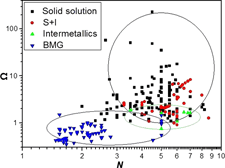Crossref Citations
This article has been cited by the following publications. This list is generated based on data provided by
Crossref.
Li, Jiemin
Yang, Xiao
Zhu, Ruanli
and
Zhang, Yong
2014.
Corrosion and Serration Behaviors of TiZr0.5NbCr0.5VxMoy High Entropy Alloys in Aqueous Environments.
Metals,
Vol. 4,
Issue. 4,
p.
597.
Yeh, Jien-Wei
2015.
Physical Metallurgy of High-Entropy Alloys.
JOM,
Vol. 67,
Issue. 10,
p.
2254.
Guo, S.
2015.
Phase selection rules for cast high entropy alloys: An overview.
Materials Science and Technology,
Vol. 31,
Issue. 10,
p.
1223.
Zhang, B.
Gao, M. C.
Zhang, Y.
Yang, S.
and
Guo, S. M.
2015.
Senary refractory high entropy alloy MoNbTaTiVW.
Materials Science and Technology,
Vol. 31,
Issue. 10,
p.
1207.
Tang, Zhi
Senkov, Oleg N.
Parish, Chad M.
Zhang, Chuan
Zhang, Fan
Santodonato, Louis J.
Wang, Gongyao
Zhao, Guangfeng
Yang, Fuqian
and
Liaw, Peter K.
2015.
Tensile ductility of an AlCoCrFeNi multi-phase high-entropy alloy through hot isostatic pressing (HIP) and homogenization.
Materials Science and Engineering: A,
Vol. 647,
Issue. ,
p.
229.
Gao, M. C.
Carney, C. S.
Doğan, Ö. N.
Jablonksi, P. D.
Hawk, J. A.
and
Alman, D. E.
2015.
Design of Refractory High-Entropy Alloys.
JOM,
Vol. 67,
Issue. 11,
p.
2653.
Jiao, Zhi-Ming
Ma, Sheng-Guo
Yuan, Guo-Zheng
Wang, Zhi-Hua
Yang, Hui-Jun
and
Qiao, Jun-Wei
2015.
Plastic Deformation of Al0.3CoCrFeNi and AlCoCrFeNi High-Entropy Alloys Under Nanoindentation.
Journal of Materials Engineering and Performance,
Vol. 24,
Issue. 8,
p.
3077.
Guo, N.N.
Wang, L.
Luo, L.S.
Li, X.Z.
Su, Y.Q.
Guo, J.J.
and
Fu, H.Z.
2015.
Microstructure and mechanical properties of refractory MoNbHfZrTi high-entropy alloy.
Materials & Design,
Vol. 81,
Issue. ,
p.
87.
Ye, Y.F.
Wang, Q.
Zhao, Y.L.
He, Q.F.
Lu, J.
and
Yang, Y.
2016.
Elemental segregation in solid-solution high-entropy alloys: Experiments and modeling.
Journal of Alloys and Compounds,
Vol. 681,
Issue. ,
p.
167.
Zhang, Yong
Qiao, Jun-wei
and
Liaw, Peter K.
2016.
A Brief Review of High Entropy Alloys and Serration Behavior and Flow Units.
Journal of Iron and Steel Research International,
Vol. 23,
Issue. 1,
p.
2.
Zhang, Yong
Guo, Sheng
Liu, C. T.
and
Yang, Xiao
2016.
High-Entropy Alloys.
p.
21.
Tsau, Chun-Huei
and
Lee, Po-Yen
2016.
Microstructures of Al7.5Cr22.5Fe35Mn20Ni15 High-Entropy Alloy and Its Polarization Behaviors in Sulfuric Acid, Nitric Acid and Hydrochloric Acid Solutions.
Entropy,
Vol. 18,
Issue. 8,
p.
288.
He, Feng
Wang, Zhijun
Shang, Xuliang
Leng, Chao
Li, Junjie
and
Wang, Jincheng
2016.
Stability of lamellar structures in CoCrFeNiNbx eutectic high entropy alloys at elevated temperatures.
Materials & Design,
Vol. 104,
Issue. ,
p.
259.
Melnick, A. B.
and
Soolshenko, V. K.
2016.
Prediction of Stable Composition for High-Entropy Refractory Alloys.
METALLOFIZIKA I NOVEISHIE TEKHNOLOGII,
Vol. 38,
Issue. 10,
p.
1395.
Santodonato, Louis J.
and
Liaw, Peter K.
2016.
High-Entropy Alloys.
p.
115.
Yao, Hongwei
Qiao, Jun-Wei
Gao, Michael
Hawk, Jeffrey
Ma, Sheng-Guo
and
Zhou, Hefeng
2016.
MoNbTaV Medium-Entropy Alloy.
Entropy,
Vol. 18,
Issue. 5,
p.
189.
Gao, M. C.
Zhang, B.
Yang, S.
and
Guo, S. M.
2016.
Senary Refractory High-Entropy Alloy HfNbTaTiVZr.
Metallurgical and Materials Transactions A,
Vol. 47,
Issue. 7,
p.
3333.
Feng, Rui
Gao, Michael
Lee, Chanho
Mathes, Michael
Zuo, Tingting
Chen, Shuying
Hawk, Jeffrey
Zhang, Yong
and
Liaw, Peter
2016.
Design of Light-Weight High-Entropy Alloys.
Entropy,
Vol. 18,
Issue. 9,
p.
333.
Ye, Y.F.
Wang, Q.
Lu, J.
Liu, C.T.
and
Yang, Y.
2016.
High-entropy alloy: challenges and prospects.
Materials Today,
Vol. 19,
Issue. 6,
p.
349.
Meng, G.H.
Lin, X.
Xie, H.
Yue, T.M.
Ding, X.
Sun, L.
and
Qi, M.
2016.
The effect of Cu rejection in laser forming of AlCoCrCuFeNi/Mg composite coating.
Materials & Design,
Vol. 108,
Issue. ,
p.
157.



